Hôtel de Besenval
The Hôtel de Besenval is a historic hôtel particulier in Paris with a cour d'honneur and a large English landscape garden, an architectural style commonly known as entre cour et jardin – meaning a residence between the entrance court in front of the building and the garden behind it. The building is listed as a historical monument by decree of 20 October 1928. It houses the Embassy of the Swiss Confederation and the residence of the Swiss ambassador to France since 1938.[1]
| Hôtel de Besenval | |
|---|---|
 The main entrance of the Embassy of the Swiss Confederation and the residence of the Swiss ambassador to France. | |
| General information | |
| Type | Hôtel particulier |
| Address | 142 Rue de Grenelle |
| Town or city | Paris |
| Country | |
| Current tenants | |
| Construction started | 1704 |
| Completed | 1862 |
| Owner | |
| Design and construction | |
| Architect(s) | Pierre-Alexis Delamair and Alexandre-Théodore Brongniart |
Location
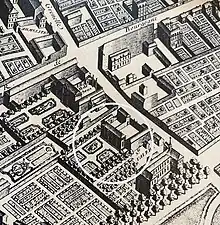
The premises are at 142 Rue de Grenelle in the district of Faubourg Saint-Germain in the 7th arrondissement, opposite the Hôtel du Châtelet and close to the Hôtel des Invalides.
The Faubourg Saint-Germain has long been known as the favourite home of the French nobility and hosts numerous aristocratic hôtels particuliers. Many of these residences later became foreign embassies and ambassadorial residences or administrative headquarters of the City of Paris or seats of ministries of France.
In the early 18th century, the French nobility started to move from the Marais, the then aristocratic district of Paris where nobles used to build their hotels particuliers, to the clearer, less populated and less polluted Faubourg Saint-Germain; an area which soon became the new residential area of France's highest ranking nobility. Families like those of the Duc d’Estrées, the Duc du Châtelet or the Duc de Noirmoutier moved there. Their former residences still bear their names today. Therefore, the instinct of the early investors was right when they bought at the beginning of the 18th century their plots of land on what would soon become one of the best addresses in Paris: The Rue de Grenelle.[3]
History
Hôtel Chanac de Pompadour

The origins of the Hôtel de Besenval go back to a single-floor residence, the Hôtel Chanac de Pompadour, erected in 1704 for a man of the Church, Pierre Chanac Hélie de Pompadour, Baron de Treignac, Abbé de Vigeois, Prieur de La Valette and Prévost d'Arnac. It is believed that the abbé was a descendant of the family of Guillaume V de Chanac (1248–1348), Évêque de Paris from 1333 until 1342.
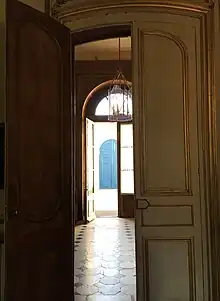
For the design and the construction of his new residence, the abbé commissioned the celebrated architect Pierre-Alexis Delamair. Delamair was very much in demand at the time. It was around the same time when he was involved in two other major building projects in Paris: the remodeling of the Hôtel de Clisson, lately known as the Hôtel de Guise, for François de Rohan, Prince de Soubise, which consequently became the Hôtel de Soubise and the construction of the Hôtel de Rohan for Armand Gaston Maximilien, Prince de Rohan.[4][3]
Pierre-Alexis Delamair's one-off project
.png.webp)
The Hôtel Chanac de Pompadour is a special feature in Delamair's work, as it is the only single-floor hôtel particulier he ever designed. With the Hôtel Chanac de Pompaodur, Delamair also set new standards in façade architecture. The sober, linear neoclassical façade was a novelty and a contrast to the ornate façades that had prevailed up to that point. Architects, who later made changes to the building, always respected Delamair's basic structure and design.
In his book titled: Nouvelle description de la ville de Paris et de tout ce qu’elle contient de plus remarquable (New description of the City of Paris and all that what it contains most remarkable), first published in 1713, Germain Brice (1652–1727) describes the Hôtel Chanac de Pompadour as a pleasant place. He states: "Abbé Pierre Chanac de Pompadour has erected a house which is decorated with a number of vases and figures." Further Brice points out: "The apartments enjoy an advantageous view and the house, actually built in a rather light way, does not fail to provide several amenities which make the residence pleasant."
.jpg.webp)
And in his 1752 publication on French architecture, Jacques-François Blondel points out that at the Hôtel Chanac de Pompadour the kitchen is no longer housed in the corps de logis but in a side wing to the left (west wing). An architectural arrangement that Blondel describes as an innovation. On the one hand, keeping kitchen odors away from the state rooms and, on the other hand, reducing the risk of fire in the corps de logis. In addition to the kitchen, Delamair also combined the other utility rooms in the west wing, such as the servant’s quarters. Furthermore, Blondel praises the generally clever room layout of the house, especially of the corps de logis, which he says can be traced back to the cleverly arranged enfilades. By this he means, on the one hand, the enfilade that connects the main entrance, the vestibule and the Sallon servant de salle à manger (F) and ultimately leads to the garden (south to north) and, on the other hand, the enfilade that connects the three state rooms, the Sallon servant de salle à manger (F), the Chambre de parade (D) and the Grand cabinet (E) (west to east). The two enfilades intersect in the Sallon servant de salle à manger (F), which is now called the Salon des perroquets. Around the so-called basse-cour (the small courtyard) on the east side of the cour d'honneur, Delamair grouped the stables, the tack room and the coach houses, as well as the hen house.
After the death of the abbé in 1710, the property was inherited by his niece Marie Françoise Hélie de Pompadour, Marquise de Hautefort (1648–1726), and his grandniece Marie Anne Henriette d'Espinay, Marquise de Saint-Luc (1673–1731). Their heirs kept the residence until 1747, when they sold it to the widow Madeleine Angélique Neufville de Villeroy, Duchesse de Boufflers. After her marriage on 29 June 1750 to Charles II Frédéric de Montmorency, Duc de Piney-Luxembourg, the Duchesse de Boufflers, now the Duchesse de Piney-Luxembourg, sold the Hôtel Chanac de Pompadour in the same year to Louis-Guy de Guérapin, Baron de Vauréal et Comte de Belleval, the French ambassador in Madrid and Évêque de Rennes.[4][3][5][6][7][8][9]
The baron, the family and an extravagance

It was on 1 October 1764, when Pierre Victor, Baron de Besenval de Brunstatt, a Swiss military officer in French service, first rented the Hôtel Chanac de Pompadour before he bought the property on 5 December 1767 at auction from the many heirs of Louis-Guy de Guérapin, Baron de Vauréal et Comte de Belleval, for 170,100 livres, of which 6,000 livres for the furniture. The baron, who mainly grew up in France and who was very close to King Louis XVI and especially Queen Marie Antoinette, was a descendant of one of the richest and most powerful patrician families of Solothurn. Among other holdings, the family called the Palais Besenval and the Schloss Waldegg their own; the latter was also the birthplace of Pierre Victor de Besenval on 14 October 1721.[10][11][12][13]
Well connected: The French and the Polish connections
%252C_by_Nicolas_de_Largilli%C3%A8re.jpg.webp)
The family de Besenval or von Besenval, as they were called in their hometown Solothurn, had long and close ties to the French royal family, the House of Bourbon, also because of their family ties to the highest circles in Poland.
Pierre Victor de Besenval de Brunstatt was the son of Jean Victor de Besenval de Brunstatt, who was a colonel in the regiment of the Swiss Guards of France. Jean Victor was a descendant from a family originally from Torgnon in the Aosta Valley who had risen socially in the service of King Louis XIV and had received a title of baron of the Holy Roman Empire from Emperor Leopold I in 1695. Pierre Victor's mother was Katarzyna Bielińska (1684–1761), daughter of Kazimierz Ludwik Bieliński, a noble, politician, diplomat and cousin of King Stanisław Leszczyński, as well as sister of Franciszek Bieliński, both Grand Marshals of the Crown in Poland under the reign of King Stanisław Leszczyński, where Pierre Victor's father had served as French ambassador.
.jpg.webp)
Pierre Victor's mother became almost overnight an important figure at the royal court of France when, on 15 August 1725, King Louis XV married Marie Leszczyńska, her cousin, at least that's the rumour that's been spread. A rumour that the Baronne de Besenval never denied.
However, in September 1725, Voltaire wrote from the Château de Versailles to Madame La Présidente de Bernières, Marguerite-Madeleine du Maignart, Marquise de Bernières, née du Moustier (1698 –1767), Châtelaine of the Château de la Rivière-Bourdet: "Everyone here pays court to Madame de Besenval, who is somewhat related to the queen. This lady, who has spirit, receives with great modesty the marks of homage bestowed on her. I saw her yesterday with the Maréchal de Villars. She was asked how she was related to the queen; she replied that queens had no relatives." [15]
This somewhat enigmatic answer from the Baronne de Besenval, however, left room for speculation about the real degree of kinship with the queen.
Whatever the degree of kinship: from this point on, the influence of the family at the royal court increased significantly. An impressive example of this is that the King of France erected the de Besenval's possession of Brunstatt in the Alsace into a French barony on 11 August 1726. Hence the family name de Besenval de Brunstatt.
As a child Pierre Victor lived with his two uncles and further family members in Solothurn at the Palais Besenval and the family's country estate, the Schloss Waldegg. In 1726, when he was five years old, his mother brought him to France, where his parents already lived. The family lived in a hôtel particulier on the Rue de Varenne in Paris. But they also had an apartment near the Château de Versailles. A few years later, on 4 April 1731, at the age of nine, Pierre Victor joined, as a cadet, the regiment of the Swiss Guards, of which his father had become a colonel.[17][18][19][20]
Construction work: The nymphaeum
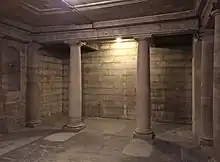
At the beginning of the 1780s, the art-loving baron could already look back on an impressive military career. After being appointed military governor of Haguenau in 1766, he was made lieutenant-colonel of the Swiss Guards in 1767 and was promoted to commander-in-chief of the troops and garrisons in the interior of France in 1781.
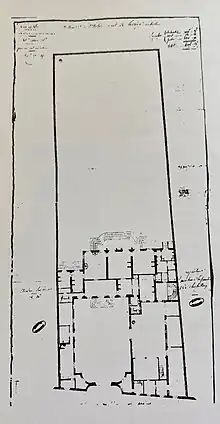
Pierre Victor de Besenval wished that his residence would reflect his achievements and his status. It was therefore only consequent, that in 1782 he employed the celebrated architect Alexandre-Théodore Brongniart to enlarge and transform his residence on the Rue de Grenelle. Among Brongniart's additions were a long gallery with skylight for the baron's constantly growing art collection, a dining room and an extravagance: a nymphaeum – a private bath with a pool in the antique style.
Thanks to his contacts with his friends at the Académie royale de peinture et de sculpture, of which he was named an Amateur-Honoraire in February 1784, the baron surrounded himself with quality French art works, signed by Le Nain, Charles-André van Loo, Pierre Mignard, Jean-Baptiste Greuze, Antoine Watteau, Jean-Marc Nattier and Henri-Pierre Danloux just to name a few. The baron also owned a version of La Gimblette (girl playing with a dog) by Jean-Honoré Fragonard. This painting hung in the adjoining room of his bedroom, now called the Salon de l'alcôve or Le Boudoir (it was said that the baron owned the first version).
.jpg.webp)
It was also thanks to the contacts to the academy, that the baron could win the sculptor Claude Michel for the decoration of his nymphaeum. Claude Michel created among others limestone reliefs with erotic scenes, which later formed part of the interior decoration of the entrance hall of the Château de Digoine in Palinges and since 1987 form part of the collections of the Louvre (today plaster replicas can be seen in the entrance hall of the Château de Digoine). The Château de Digoine and the Hôtel de Besenval were simultaneously owned by the family de Moreton de Chabrillan and their descendants for over 100 years.[10][4][22][23]
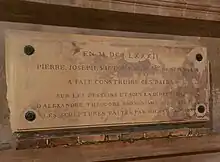
The nymphaeum with its suggestive decoration became very popular with the Parisian high society. Almost immediately rumors about scandalous behavior in the nymphaeum spread around the salons, and this only confirmed the baron's reputation as a lover and seducer. His contemporaries described the baron as extremely handsome, cheerful and witty. As a personality who is very popular with the ladies, loves life and always sees things positively. Qualities that ultimately enabled him to be accepted into the private circle of the Société de la Reine (the Queen’s Society).
Regarding the use of the nymphaeum, already contemporary observers noted that although the pool was filled with hot water, the basement itself was ice cold. Therefore, the nymphaeum was probably only used to a limited extent as a place for love adventures. Furthermore, it was said that the pool was actually used only once, by a soldier of the Swiss Guards who shortly afterwards died of pneumonia.[4][24][12]
Revolutionary years: The events come thick and fast
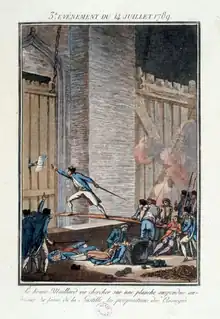
By 1789, at the dawn of the French Revolution, Pierre Victor de Besenval had accumulated the positions of lieutenant-general of the king's armies, lieutenant-colonel of the Swiss Guards, and commander-in-chief of the troops and garrisons in the interior of France. In addition, he was also a bearer of the prestigious Order of Saint Louis.
On 5 May, Les États Généraux were convened in Versailles. The baron, who attended the opening ceremony, remarked that the royal court underestimated the seriousness of the situation.
On 1 July, the baron received a ministerial letter informing him that the king had decided to regroup all his troops under a single command and entrusted them to the Maréchal de Broglie. Clearly, the baron was removed from the command of his troops of the Île-de-France and the garrison of Paris. He was now doomed to await and obey orders. However, under the supreme command of the Maréchal de Broglie, he was in command of the troops sent to Paris to quell the riots.
While still maintaining order in Paris in May by drastic measures, the baron withdrew the troops from Paris on 12 July in the hope of avoiding a bloodbath. However, this enabled the Taking of the Bastille on 14 July by revolutionary insurgents. On the part of the aristocrats, the baron was heavily criticized for his behavior. François-Emmanuel Guignard, Comte de Saint-Priest, was furious and accused the baron of incompetence. In his memoirs he wrote contemptuously: "A dozen battalions of foreign troops stationed on the Champ de Mars and a few regiments of cavalry were available to the Baron de Besenval, Swiss lieutenant-general and commander of Paris. Besenval didn't show up, didn't give orders, and locked himself in his house for fear that people might come and loot it." [28]
In his memoirs, which were only published after his death, the baron confirmed that he had acted on the orders of the Maréchal de Broglie that day:
"Weakened by the defection [of some soldiers] and certain that I was useless, I decided to return [with the troops] to Sèvres at nightfall; and as soon as the troops were in motion, I received orders from the Maréchal de Broglie to retreat."
— Pierre Victor, Baron de Besenval, [29]
This incident has since been considered the beginning of the French Revolution.
The baron, accused of high treason by the aristocrats and of the crime of lèse-nation by the revolutionaries, had no choice but to flee to Switzerland, his home country.[30][18][31]
Besenval’s escape, arrest, release and death

The baron was not only hated by the revolutionary masses as a soldier, but also suspected as a close friend of Queen Marie Antoinette. When the revolutionary masses demanded his head, the baron obtained permission from the king to leave for Switzerland, after having written to him on 19 July. In Switzerland, he intended to retire to his country estate, the Schloss Waldegg, near Solothurn. But just a day after his departure from Paris, the baron was recognized by revolutionary troops during his trip at the auberge in Villegruis near Provins on 26 July. He was immediately arrested and imprisoned at the Château de Brie-Comte-Robert, before being charged with the crime of lèse-nation in mid-October and transferred to the prison Grand Châtelet in Paris on 7 November. In his prison cell, the baron was allowed to be served by his valet, who ordered the baron's meals from the best caterers in town. Furthermore, he was allowed to receive visitors, who came in large numbers. Among others, he received Gouverneur Morris, the future Ambassador of the United States of America to France, on 17 November, to whom the baron reported that he is convinced that a counter-revolution will soon take place. Another visitor was the painter Hubert Robert, whose painting Vue de la cellule du Baron de Besenval à la prison du Châtelet (View from the Baron de Besenval's cell in the Châtelet prison) bears witness to his visit to this day. The painting forms part of the collections of the Louvre since 2012.[32]
It was only through the intervention of the Geneva banker and French finance minister Jacques Necker that the baron escaped lynching when he was arrested in Villegruis. Eventually, the baron was released on 1 March 1790 after winning his case before the court of the Grand Châtelet, thanks to the indefatigable support of his soldiers, who testified in his favour. But also thanks to the closing argument of his lawyer, Raymond Desèze, and thanks to Jacques Necker, who had held his protective hand over him. Saved from the guillotine and released from prison, the baron returned the same day to his residence on the Rue de Grenelle, protected by the Swiss Guards and escorted by a crowd of friends.
_as_Sultana_(Jean-Marc_Nattier)_-_Nationalmuseum_-_18145.tif.jpg.webp)
However, not everyone was enthusiastic about this verdict. And quite a few saw this judgment as a courtesy judgment for the Swiss Guards, who were favored by the royal court, and as a concession to Jacques Necker, who demanded a pardon for Pierre Victor de Besenval at a meeting at the Hôtel de Ville in Paris on 30 July 1789. Necker asked in his statement: "It is not only before you, it is before the most unknown, the most obscure of the citizens of Paris, that I prostrate myself, that I throw myself on my knees to ask that no one exercise, neither towards M. de Besenval nor towards anyone else, no rigors similar in any way to those that I have been told... What I ask is consideration for a foreign general, if he only needs that; it's indulgence and kindness, if he needs more… I would be very happy if this example became the signal for an amnesty which would restore calm to France." [33]
In his Mémoires d'Outre-Tombe, published in 1849 and 1850, François-René de Chateaubriand commented cynically on Pierre Victor de Besenval's acquittal: "This incriminated baron compromised in the affair of the Bastille, saved by M. Necker and by Mirabeau, only because he was Swiss: what misery!" [34]
_(2).jpg.webp)
After his release, Pierre Victor de Besenval resumed his work in the king's service. But soon he was no longer able to hold office, as the six-month imprisonment and the ongoing danger to his life had severely affected his health. His condition worsened day by day.
The baron died on 2 June 1791 after dinner in the bedroom at his residence in Paris surrounded by twenty five friends and relatives including his mistress Catherine-Louise, Marquise de La Suze, née de Santo-Domingo (1757–1826), wife of Louis-François de Chamillart, Marquis de La Suze, and his son Joseph-Alexandre Pierre, Vicomte de Ségur. The autopsy found the cause of death to be a polyp in the heart.
"Le Suisse le plus français qui ait jamais été" (the most French Swiss ever), as Charles Augustin Sainte-Beuve once called Pierre Victor, Baron de Besenval, was buried on 6 June 1791 in the church of Saint-Sulpice in Paris in the presence of his friends and his only child, his son Joseph-Alexandre Pierre, Vicomte de Ségur.[30][35][36][37][38][39]
From Besenval’s death in 1791 to 1925
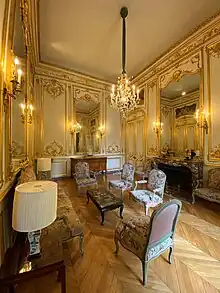
In his will of 20 December 1784, Pierre Victor de Besenval, who was never married, bequeathed the usufruct of his residence on the Rue de Grenelle to his lifelong friend, the Maréchal Philippe Henri, Marquis de Ségur, whose second son, Joseph-Alexandre Pierre, Vicomte de Ségur, was in fact the baron's illegitimate son, which was no secret within the family. The baron's relationship with his best friend's wife, Louise-Anne de Vernon, Marquise de Ségur (1729–1778), which lasted until her death, and the illegitimate son did not cloud the relationship between the spouses or between Besenval and his best friend. But on the contrary. The three enjoyed being together. The baron spent a lot of time in the château of the Marquis de Ségur in Romainville where he could pursue another passion: the art of horticulture (the last remains of the Château de Ségur were demolished in 2017). Furthermore, it was the intention of both, the Baron de Besenval and the Marquis de Ségur, that one day the baron’s son would inherit the Hôtel de Besenval. Consequently, the baron bequeathed the bare ownership of the Hôtel de Besenval to his biological son Joseph-Alexandre Pierre, Vicomte de Ségur. The physical resemblance between Pierre Victor de Besenval and his son was noticed and discussed by contemporaries, including Gouverneur Morris, who wrote in his diary after a visit to the Hôtel de Besenval on 27 March 1789: "I then went to the Baron de Besenval. The company is not numerous, and there is the Vicomte de Ségur, who passes for the son of the baron; one must admit that he really is, if one accepts as proof their physical resemblance and their mutual tenderness. This young man is the Lovelace of the day, and as remarkable as his father as a seducer." [44][45][31]
A treasure house is being auctioned off: The sale of the Hôtel de Besenval
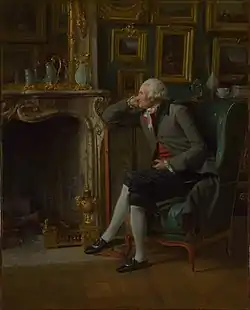
During the French Revolution, the family de Ségur was largely dispossessed. Consequently, the family was in need of money. Therefore, the Marquis de Ségur and the Vicomte de Ségur decided to sell the entire contents of the Hôtel de Besenval at auction on 10 August 1795. The auction with 222 lots was conducted by Alexandre Joseph Paillet (1743–1814), a prominent auctioneer in Paris at the end of the 18th century. Between 1777 and 1789, Paillet also acted as an agent for the crown, acquiring paintings for the museum in the Louvre.
In the foreword to the auction catalogue, Alexandre Joseph Paillet praises the baron's collection: "The precious and considerable collection of which we are presently announcing the public and detailed sale by auction, will again offer amateurs a brilliant opportunity to acquire distinguished and choice objects in the different kinds of curiosity of which it is composed." [50]
It is an irony of history that the entire contents of the Hôtel de Besenval were sold at auction, because Pierre Victor de Besenval rarely bought at auctions. He preferred to buy his furniture and artworks either directly from the artists or from established dealers such as Lazare Duvaux. The proceeds from the auction were almost two million livres. An enormous sum which helped to financially rehabilitate the family de Ségur.[51]
A taste for the finer things in life

The considerable auction proceeds show what treasures the baron had amassed in the Hôtel de Besenval over the course of his life. Even his contemporaries knew how to report that the Hôtel de Besenval was a real treasure house.
The prestige of his collection was such that one could almost take at face value the scathing remarks of François-Emmanuel Guignard, Comte de Saint-Priest, accusing the baron of having selfishly preferred to let the looting of the Hôtel des Invalides happen on 14 July 1789 by rioters who seized the cannons and muskets stored in its cellars to use against the Bastille later the same day, for fear that his nearby home, the Hôtel de Besenval, might otherwise have been looted.[52][28]
The description of the Baron de Besenval's residence with many accurate details about the ornaments of the wood panelling and the stucco ceilings of the different rooms as well as of the artworks and the furnishings by Luc-Vincent Thiéry (1734–1822) in his Guide des amateurs et des étrangers voyageurs à Paris, published in 1787, the annotations in the Abbé Le Brun's Almanach historique et raisonné des architectes, peintres, sculpteurs, graveurs et cizeleurs of 1777 about the baron's rich cabinet of paintings from The Three Painting Schools (France, Italy and the Netherlands), together with the baron's 1795 collection sale catalogue by Alexandre Joseph Paillet, offer a remarkably comprehensive picture of his distinctive taste for luxurious furniture, porcelain, paintings, sculptures and objets d’art. Or as Henriette Campan, Première Femme de Chambre of Queen Marie-Antoinette put it: "Le Baron de Besenval avait conservé la simplicité des Suisses, et acquis toute la finesse d’un courtisan français" (the Baron de Besenval had retained the simplicity of the Swiss, and acquired all the finesse of a French courtier).[53]
Some of the baron's treasures are also visible on the portrait titled: Le Baron de Besenval dans son salon de compagnie, painted by Henri-Pierre Danloux in 1791 and now hanging in the National Gallery.[54][55][56]
The baron's Last Sitting – Danloux's iconic portrait
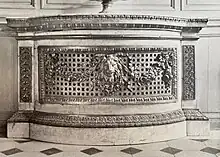
Colin B. Bailey describes the iconic portrait Le Baron de Besenval dans son salon de compagnie as Henri-Pierre Danloux's "most accomplished Parisian portrait" and notes that this intimate picture "deserves to be known as the single oil painting produced in the 18th century of a French private collector in his picture cabinet." This painting was one of the few pieces not for sale at the auction in 1795. The baron's son, Joseph-Alexandre Pierre, Vicomte de Ségur, kept his father's portrait in his possession until his death in 1805.
It was to be one last for both, Besenval and Danloux: Besenval died shortly after the portrait was completed in 1791, and for Danloux it was his last major portrait commission before he left France because of the turmoil of the Revolution and emigrated to the United Kingdom.

Even today, most of the paintings, which are visible on this portrait, displayed against green damask, can be identified. According to Colin B. Bailey, paintings of the following artists are visible: Cornelis van Poelenburgh, Willem van de Velde, David Teniers, Aelbert Cuyp, Claude-Joseph Vernet and Carlo Maratta. Also most of the other objects visible on the portrait can be identified and sometimes even traced back to their whereabouts, like the pieces of Chinese celadon porcelain placed on the fireplace mantel, which were sold at auction in 2021 by Christie's in London. Furthermore, some pieces of Japanese porcelain are visible on an armoire à hauteur d'appui, made in the style of André-Charles Boulle (one of a pair, made in contre-parti, and almost certainly lots 186 and 187 in the baron's 1795 collection sale catalogue). Among the Japanese porcelain pieces on the armoire à hauteur d'appui are an Arita carp vase and a Kakiemon bottle. The beautifully crafted pair of gilt bronze chenets to the baron's feet (only one of the pair is visible) and the gilt bronze wall-lights on both sides of the mirror (only the lower part of the one on the right-hand side is visible, showing a ram's mask on the back-plate) can be attributed to Philippe Caffieri and were probably made en suite (two pairs of these wall-lights are known: one at the Royal Palace of Stockholm and the other in a private collection).
This shows, on the one hand, the exquisite taste of the baron, whom Luc-Vincent Thiéry once called "homme de goût et de connaissances" (man of taste and knowledge), and, on the other hand, with what precision Henri-Pierre Danloux has executed this last portrait of Pierre Victor de Besenval. Over the years, many of the baron's treasures have found new homes in world renowned museums or distinctive private collections such as the Louvre, the National Gallery, the Hermitage Museum, the Royal Collection, the Wallace Collection and the Metropolitan Museum of Art.[59][54][42][60][61][62][63][64][49][65]
The Besenval era is coming to an end: The Comtesse de Moreton de Chabrillan
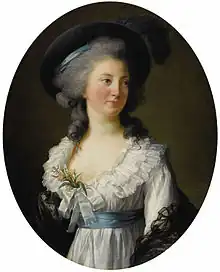
Unlike the property and the fortune of the family de Ségur, the Hôtel de Besenval was exempt from expropriation by the revolutionary government, since the former property of the Baron de Besenval was still considered Swiss-owned. In this context, it paid off for the Vicomte de Ségur to ensure that, during the worst phase of the revolutionary turmoil, he was only perceived as executor of Pierre Victor de Besenval's will and not as his heir.[51]
Already in 1780 the Baron de Besenval had bought a hôtel particulier on 6 Rue Chantereine for his son, the Vicomte de Ségur. The Marquis de Ségur lived in the Hôtel de Ségur on 9 Rue Saint-Florentin. Thus, neither the Marquis de Ségur nor the Vicomte de Ségur had the intention to move permanently into the Hôtel de Besenval. However, shortly after his father's death, the Vicomte de Ségur seemed to have lived at the Hôtel de Besenval for at least some time.
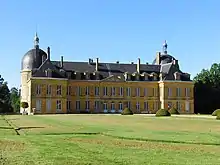
In 1795 the Marquis de Ségur and the Vicomte de Ségur decided to let the Hôtel de Besenval to Francesco-Saverio, Conte di Carletti (1740–1803), the Minister of the Grand Duchy of Tuscany in Paris. But just two years later, on 14 October 1797, the Vicomte de Ségur sold the Hôtel de Besenval to Marie-Elisabeth-Olive Guigues, Comtesse de Moreton de Chabrillan, née Frotier de La Coste-Messelière (1761–1807), widow of Jacques Henri Sébastien César Guigues, Comte de Moreton de Chabrillan. The family of the Comtesse also owned the Château de Digoine in Palinges. The Comtesse's grandfather was Claude Léonor de Reclesne, Marquis de Digoine (1698–1765).

It was the son of the Comtesse de Moreton de Chabrillan, Aimé Jacques Marie Constant Guigues, Comte de Moreton de Chabrillan, Chambellan to Emperor Napoleon by decree of 21 December 1809, whom Napoleon created Comte de l'Empire by letters patent of 19 January 1811, who later brought all the decorative elements of the baron's nymphaeum to the Château de Digoine and used them to adorn the entrance hall and the grand staircase of the château. Most of these decorative elements were made by Claude Michel, like the limestone reliefs with erotic scenes which form part of the collections of the Louvre since 1987.
The family de Moreton de Chabrillan and their descendants kept the Hôtel de Besenval in their possession until 1925. In later years, they also rented it out, including to members of the family Bonaparte.[45][5][31][68]
Construction work: The family Bonaparte

It was in 1862, during the time when the Hôtel de Besenval belonged to Marie Jacqueline Sidonie, Marquise de Montholon-Sémonville, née Guigues de Moreton de Chabrillan (1810–1890), daughter of Aimé Jacques Marie Constant Guigues, Comte de Moreton de Chabrillan, and her husband, Louis François Alphonse, Marquis de Montholon-Sémonville (1808–1865), Prince d’Umbriano del Precetto, and Chevalier de la Légion d'honneur, that the corps de logis was altered to its present appearance after the design of the architect Chabrier. The house was enlarged with another floor and an attic with a comble à la Mansart.[69]
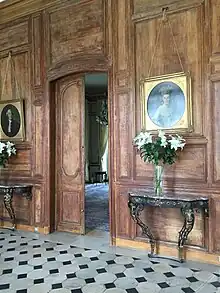
This construction work massively changed the external appearance of the single-floor residence. Whereas the corps de logis previously had the appearance and the architectural lightness of a pleasure pavilion, the Hôtel de Besenval now changed its appearance to become a house with a certain severity and seriousness, a residence suitable for a family.
The family de Montholon was very close to the French imperial family, the House of Bonaparte. Charles Tristan, Marquis de Montholon, was a general under Emperor Napoleon and followed him into exile on 8 August 1815 on Saint Helena. Therefore, it doesn't come as a surprise, that between 1855 and 1870 the Princes Lucien and Joseph Lucien Bonaparte, sons of Charles Lucien Bonaparte and therefore descdendants of Lucien Bonaparte, younger brother of Emperor Napoleon, resided at the Hôtel de Besenval.
.jpg.webp)
It was also at the request of the family Bonaparte, that the family de Montholon-Sémonville commissioned the extension of the building and the construction of the new suites of rooms on the first floor, so that also other members of the family Bonaparte could temporarily stay at the Hôtel de Besenval, such as Princesse Charlotte Honorine Joséphine Bonaparte (1832–1901).
Today the ambassador's office and other offices and meeting rooms are located on the first floor. Part of the first floor also houses the ambassador's private quarters. The layout and the decoration of these rooms is rather simple compared to the state rooms on the ground floor.[22][70][31][57]
Embassy of the Swiss Confederation (until 1957 as the Swiss Legation)
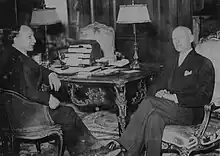
In the aftermath of World War I, the Hôtel de Besenval served, amongst others, as the seat of various international arbitral tribunals provided for in the peace treaties. Years earlier, in 1925, Jean de Montholon, a descendant of Marie-Elisabeth-Olive Guigues, Comtesse de Moreton de Chabrillan, who bought the Hôtel de Besenval in 1797, sold the Hôtel de Besenval for FRF3,000,000 to the public company Société immobilière Pompadour, whose majority shareholders were Emily Grace Baumann, née Kinsley (1862–1951), widow of Gustav Baumann (1853–1914), a Swiss gentleman from St. Gallen, and her son, Clifton K. Baumann (1893–1936). However, Emily Grace Baumann and her son Clifton only lived in the Hôtel de Besenval temporarily between 1930 and 1931. The property, which was now subdivided into apartments, continued to be occupied primarily by tenants until it was sold in 1938. One of the more illustrious tenants was George Bakhmeteff, the last tsarist Russian Ambassador to the United States. The last tenant to leave the Hôtel de Besenval before it was taken over by the Swiss Confederation was retired US Ambassador Robert Peet Skinner, former US Ambassador to Greece, Estonia, Latvia, Lithuania and Turkey.
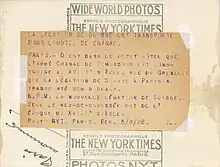
From the mid-1930s, the threat of war in Europe steadily increased. Accordingly, the Federal Council was concerned about the country's balance and independence. Therefore, the Swiss Foreign Minister Giuseppe Motta decided to strengthen Switzerland's presence in some important capitals. Part of this strategy was the plan to purchase representative embassy and legation buildings in strategically favorable locations, particularly in Paris, Rome and Washington (with the purchase of the Villa Kunheim in Berlin in 1919 and a mansion in London, this task had already been accomplished in these capitals).[71][72]
When the Hôtel de Besenval was put up for sale in 1937, the Swiss Government did not have to think twice. With its prime location, ideal size and storied Franco-Swiss past embodied by Pierre Victor de Besenval, it seemed like the ideal building. In the same year, negotiations began between the Société immobilière Pompadour and the Swiss Confederation. Finally, on 19 May 1938, the Swiss Confederation purchased the Hôtel de Besenval for FRF3,440,000 and moved the Swiss Legation from its previous premises at 51 Avenue Hoche to 142 Rue de Grenelle.
It was Minister Walter Stucki, Envoy of the Swiss Confederation to France, who was in charge of the purchase and the supervision of the serious renovation work of the existing buildings as well as the addition of an administrative building bordering the west court, which replaced the former west wing with the kitchen and the servant's quarters. The work was planned and carried out by the architects Moreillon & Taillens. Later, between 1967 and 1969, the west wing was expanded to include a floor and an attic based on the model of the corps de logis.
.jpg.webp)
The offices of the Swiss Legation opened in January 1939. A month earlier, in December 1938, Minister Walter Stucki was able to move into the envoy's residence. A few months later, World War II broke out.
In June 1940, after the Battle of France, the capture of Paris and the fall of the Third Republic on 22 June, the legation was downgraded to a consulate and Minister Walter Stucki as well as a large part of the French ruling elite, including the Deputy Prime Minister Philippe Pétain, withdrew to Vichy.
In the course of time, Stucki gained Pétain's trust. And on 27 August 1944, Pétain took Stucki to the Hôtel du Parc as a witness to prove that he was evacuated by the Germans against his will to Belfort. Stucki mediated between the advancing Allies, the retreating Germans and the French Resistance fighters, and saved Vichy from destruction. The grateful city government of Vichy named a street after Stucki, the Avenue Walter Stucki.
After the war in 1945, with the arrival of Minister Carl J. Burckhardt, the Hôtel de Besenval once again became the Swiss Legation.[4][73][70][74][31][75]
The Hôtel de Besenval: A place of Swiss-French diplomacy – already in Besenval's time
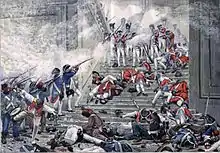
The first permanent diplomatic representation of the then Helvetic Republic in France was opened in April 1798. Head of this first diplomatic representation was the Envoy Peter Josef Zeltner from Solothurn. This was the beginning of a long line of Swiss ambassadors to France.
However, long before, individual Swiss cantons of the old Swiss Confederacy were well aware that they had to have their interests represented at the powerful French royal court. In the Ancien Régime, these tasks were either assigned to special envoys for special tasks, or the already established network by allied persons who were already on the ground was used, such as the officers of the Swiss Guards, like Pierre Victor de Besenval, and this for good reasons. The officers of the Swiss Guards were very influential at the royal court. Alain-Jacques Tornare (* 1957) describes their status as follows: "Swiss soldiers in France were not mercenaries, but an army within the army. In a broader sense, the Swiss community in France formed a state within the state. The kings showered the Swiss with privileges such as tax exemptions, legal rights and freedom of religion, so that they were more favored than the French themselves." The Swiss thanked the kings by assuring them of their reliability and loyalty. In summary, Tornare says about the importance of the Swiss Guards: "A pillar of France's Ancien Régime and a symbol of Swiss know-how." [76][77]
State rooms

The layout and the decoration of the vestibule and the three state rooms, the Salon de la tapisserie, the Salon des perroquets and the Salon des ministres (La chambre du maître), as well as the dining room, have changed little since the time of the Baron de Besenval. The designs of the architects Pierre-Alexis Delamair and Alexandre-Théodore Brongniart are still predominant, especially when it comes to the wood panelling. These rooms are still decorated in the styles of their time: Régence, Louis XV, Louis XVI and Neoclassicism.

However, it was in the first half of the 19th century that the family de Moreton de Chabrillan transformed the little adjoining room to the baron's former bedroom into a Salon de l'alcôve and embellished its wood panelling, dating originally from the 1720s, with elements in the rococo revival style, among others with four medallion paintings in the style of François Boucher, embedded in the wall panelling. Today, this room is also called Le Boudoir.
In the course of time and under the different owners, further decorative changes were made, especially before the turn of the 19th to the 20th century and in the early 20th century. Parquet floors were replaced, some fireplace mantels exchanged, the large 18th-century marble stove decorated with gilt bronzes made by Pierre Gouthière in the vestibule dismantled and sold, the double-leaf doors of the Salon de la tapisserie mirrored, and the stucco ceiling in the Chambre du maître lost its elaborate decoration (the decoration of the ceiling can still be seen in photographs from before World War I).
However, it was with great respect that the Swiss Confederation renovated these rooms after acquiring the property in 1938, which had been already a listed building for 10 years at the time.
Furthermore, from the very beginning, it was also important to the Swiss Confederation to equip the state rooms with appropriate furniture from the relevant eras and styles. And if even possible, to get some of the original furniture back that had once belonged to the furnishings of the Hôtel de Besenval.[78][79][74][41][58]
The axis Solothurn – Paris: The return of the furniture and the families de Besenval and de Broglie

A few years after the baron's death in 1791, the baron's furniture, works of art and further belongings from the Hôtel de Besenval were sold at auction in Paris on 10 August 1795. However, already during the baron's lifetime some pieces of furniture as well as paintings and further works of art from the Hôtel de Besenval were sent to his country estate in Switzerland, the Schloss Waldegg, including a furniture ensemble consisting of a sofa and six chairs painted in the so-called gris Trianon (a colour named after the Petit Trianon) and covered in beige fabric embroidered with scenes from the fables of Jean de La Fontaine.
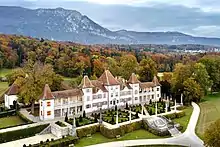
The sofa and the six chairs were bought by the Swiss Confederation in 1938 from the patrician family von Sury. Their ancestor, Josef von Sury von Bussy (1817–1887), who had been married to Charlotte de Besenval (1826–1885) since 26 June 1848, had bought the Schloss Waldegg on 6 February 1865 from the last members of the family de Besenval who were entitled to inherit. With Amédée de Besenval (1862–1927), the main line of the family died out in 1927. However, the House of Broglie are the descendants of the French line of the family de Besenval. Pierre Victor de Besenval's sister, Théodora Élisabeth Catherine, Marquise de Broglie (1718–1777), was married since 1733 to Charles Louis Guillaume, Marquis de Broglie (1716–1786), a nephew of Maréchal Victor-François, Duc de Broglie, on whose orders Besenval had withdrawn the troops from Paris on 12 July 1789. But their son, Achille Joseph, Comte de Broglie (1740–1758), died already at the age of 18. Furthermore, the couple separated later, whereupon Pierre Victor de Besenval's sister moved to the Hôtel de Besenval and ran the household for her brother. However, in 1884, Jeanne Eméline Cabot de Dampmartin (1864–1901), granddaughter of Amédée de Besenval (1809–1899), married François, Prince de Broglie (1851–1939). The descendants of this branch of the family de Broglie also had the extensive family archive in their possession until 1980, with many original documents, also from the possession of Pierre Victor de Besenval, and therefore with relevance for the history of the Hôtel de Besenval (75 boxes of documents, dating mainly from the 17th, 18th and 19th century). Today this family archive is in the state archive of the Canton of Solothurn, the hometown of the family de Besenval.
In 1938, after over 150 years, the sofa and the six chairs were brought back to the Hôtel de Besenval, where again they form part of the furnishings of the Salon de la tapisserie.[78][80][81][82][83]
Alliance Tapestry
.jpg.webp)
One of the most significant works of art in the Hôtel de Besenval today is the large 17th-century tapestry in the Salon de la tapisserie, produced in the Gobelins Manufactory after 1665. The tapestry, which was woven after a design by Charles Le Brun, is on loan by the Mobilier National.
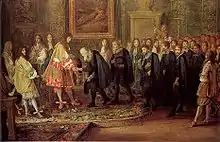
The tapestry shows the historic moment of the festivities on 18 November 1663 in the Cathédrale Notre-Dame de Paris on the occasion of the renewal of the mercenary alliance of 1521 between France and the Swiss, which was negotiated by the two parties in the aftermath of the Battle of Marignano and the peace treaty of 1516, known as Traité de Fribourg or Paix Perpétuelle (Perpetual Peace). It depicts the moment when King Louis XIV and the ambassadors of the Confederation of the XIII cantons take an oath together on the Bible. And so, one after another pronounced the oath concluded by the words of King Louis XIV: "Et moi aussi je le promets" (And I too promise it).
This tapestry is part of the fourteen-episode sequel to the King's story (Histoire du Roi). Several copies of this so-called Alliance Tapestry were made, since between 1665 and 1724 a total of seven series of the fourteen-episode sequel to the King's story were produced. In addition to the copy in the Hôtel de Besenval, there is also a copy in the Château de Versailles and a copy in the Swiss National Museum in Zurich.
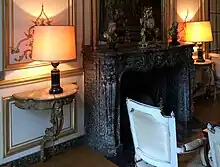
The idea of depicting the main events in the life of King Louis XIV in the medium of the tapestry goes back to Jean Chapelain, an adviser to Jean-Baptiste Colbert. The realization of the fourteen-episode sequel to the King's story – later, three more episodes were added – began in 1665. The aim was to present the most important events in the life of King Louis XIV in the military, civil and diplomatic fields. Since the royal court had a great interest in ensuring that as many people as possible knew about these glorious events, also engravings were later made of the individual tapestries, which were widely distributed and glorified and shaped the image of the king in France as well as abroad.
The renewal of the mercenary alliance with the Swiss was an important success for the French diplomacy. This is also supported by the fact that this episode was presented at all in the King's story.[78][84][85][86]
An English landscape garden in Paris
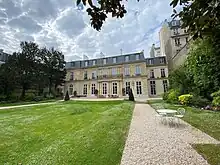
Pierre Victor de Besenval had the garden of his residence on the Rue de Grenelle converted into an English landscape garden and cultivated rare and exotic plants in specially designed greenhouses. To obtain seeds and specimens of rare plants like orchids, jasmines and tulips, the baron was able to draw on a wide network of friends. In 1785, for example, he received bulbs of unknown flowers from the Cape of Good Hope in South Africa through Colonel Charles-Daniel de Meuron from Neuchâtel.
Last but not least, the baron also managed to inspire Queen Marie Antoinette with his passion for rare plants. At his suggestion, the queen had various precious plant species planted in the garden of the Petit Trianon.[10]
A plant named after the Baron de Besenval
As in the field of the arts, the baron was also a patron in the field of botany. In 1782, Pierre-Joseph Buc'hoz named a plant after the baron to thank him for his support. Unfortunately, this plant had already received its scientific name a few years earlier and is therefore not known today as Besenvalia senegalensis but as Oncoba spinosa.[10]
Notes
- Jean-Jacques Fiechter / Benno Schubiger: L’Ambassade de Suisse à Paris, Ambassade de Suisse, 2ème édition, août 1994, p. 11
- Ventes immobilières: Adjudication définitive, du 10 février 1838, en l'audience des criées du tribunal civil de première instance du département de la Seine, Journal des débats politiques et littéraires, Paris, s.n., 7 février 1838, col. 1
- Jean-Jacques Fiechter / Benno Schubiger: L’Ambassade de Suisse à Paris, Ambassade de Suisse, 2ème édition, août 1994, p. 12
- Alain Stella: Historic Houses of Paris – Residences of the Ambassadors, Flammarion, Paris, 2010, p. 32
- Jean-Jacques Fiechter / Benno Schubiger: L’Ambassade de Suisse à Paris, Ambassade de Suisse, 2ème édition, août 1994, p. 25
- Charles Lefeuve: Histoire de Paris – rue par rue, maison par maison, 5ème édition, tome IV, C. Reinwald et Cie, 15, rue des Saints-Pères, Paris, 1875, p. 89
- Germain Brice: Nouvelle description de la ville de Paris et de tout ce qu’elle contient de plus remarquable, 8ème édition, tome III, chez Julien-Michel Gandouin, Quai de Conty, aux trois Verus, et François Fournier, rue S. Jacques, aux Armes de la Ville, Paris, 1725, pp. 453–454
- Jacques-François Blondel: Architecture Françoise, ou recueil des plans, élévations, coupes et profiles des Eglises, Maisons Royales, Palais, & Edifices les plus considérables de Paris, ainsi que des Châteaux et Maisons de plaisance situés aux environs de cette ville, ou en d’autres endroits de la France, bâtis par les plus célèbres architectes, & mesurés exactement sur les lieux, tome premier, contenant une introduction à l’architecture, un abrégé historique de la ville de Paris, & la description des principaux édifices du Faubourg St. Germain, chapitre XII: Description de l’Hôtel de Pompadour, situé rue de Grenelle. Chez Charles-Antoine Jombert, Libraire du Roi pour le Génie & l’Artillerie, rue Dauphine, Paris, 1752, pp. 236–237
- Fiske Kimball: The Creation of the Rococo, Philadelphia Museum of Art, 1943, p. 93
- Andreas Affolter: Die Leidenschaften des Herrn von Besenval, Blog Schweizerisches Nationalmuseum, 29. September 2021
- Jean-Jacques Fiechter / Benno Schubiger: L’Ambassade de Suisse à Paris, Ambassade de Suisse, 2ème édition, août 1994, p. 13
- J. Vacquier, Secrétaire général de la Société d’Histoire et d’Archéologie du VIIe Arrondissement de Paris: Les vieux hôtels de Paris – Le Faubourg Saint-Germain, décorations extérieures et intérieures, tome I, 2ème édition, F. Contet, libraire, 101, rue de Vaugirard, Paris, 1911, p. 4
- Friedrich Melchior Grimm / Denis Diderot: Correspondance littéraire, philosophique et critique, par Grimm et Diderot, depuis 1753 jusqu'en 1790, tome IV, (1764–1765), chapitre 'M. le Marquis de Sancé ayant cherché M. le Baron de Besenval – 1er octobre 1764,' Furne, libraire, 37, Quai des Augustins, Paris, 1829–1831
- Sotheby's: Nicolas de Largillièrre: Portrait of the Baron de Besenval (1671–1736) and Portrait of the Baronne de Besenval (1684–1761), the parents of Pierre Victor, Baron de Besenval (1721–1791), The Courts of Europe, New York, lot 117, 30 January 2014. Est.: $120,000 – $160,000
- François-Marie Arouet, dit Voltaire: Correspondance de Voltaire, Septembre 1725 (à Versailles), à Madame La Présidente de Bernières, Œuvres complètes de Voltaire (1877), tome 33, lettre 151, Texte établi par Louis Moland, Garnier (1883), Paris, pp. 146–147
- Jean-Jacques Rousseau: Les Confessions, Livre septième (1741), H. Launette et Cie., Éditeurs, Paris, 1889, tome 2, p. 13
- Jean-Jacques Fiechter / Benno Schubiger: L’Ambassade de Suisse à Paris, Ambassade de Suisse, 2ème édition, août 1994, p. 15
- Andreas Fankhauser: Pierre Victor Besenval de Brunnstatt in German, French and Italian in the online Historical Dictionary of Switzerland.
- Gabrielle Claerr Stamm: De Soleure à Paris : La saga de la famille de Besenval, seigneurs de Brunstatt, Riedisheim et Didenheim, Société d’Histoire du Sundgau, 2015, p. 139
- Gabrielle Claerr Stamm: De Soleure à Paris : La saga de la famille de Besenval, seigneurs de Brunstatt, Riedisheim et Didenheim, Société d’Histoire du Sundgau, 2015, p. 102
- Collections Louvre: Vase à décor d'une ronde de satyres et de satyresses en pierre de Tonnerre par Claude Michel dit Clodion, lieu de provenance: Hôtel de Besenval, élément du décor de la salle de bains, Département des Sculptures du Moyen Age, de la Renaissance et des temps modernes, salle 223, numéro d'inventaire RF 4105, date d’acquisition (dation) 20 octobre 1986
- Paris Promeneurs: Ambassade de Suisse, l’hôtel de Besenval, Blog Découvrez l’architecture de Paris et son histoire, 2023
- Gabrielle Claerr Stamm: De Soleure à Paris : La saga de la famille de Besenval, seigneurs de Brunstatt, Riedisheim et Didenheim, Société d’Histoire du Sundgau, 2015, p. 147
- Jean-Jacques Fiechter / Benno Schubiger: L’Ambassade de Suisse à Paris, Ambassade de Suisse, 2ème édition, août 1994, p. 22
- Guy Chaussinand-Nogaret: La Bastille est prise, Éditions Complexe, Paris, 1988, p. 102
- Niklaus von Flüe: Ludwig von Flüe in German, French and Italian in the online Historical Dictionary of Switzerland.
- Ludwig von Flüe: Die enthüllte Bastille – Bericht von der Eroberung der Bastille, Eigenhändiger Bericht des Offiziers der Schweizergarde Ludwig von Flüe über die Ereignisse in und um die Bastille vom 14. Juli 1789 an den Verleger der Zeitschrift Mercure de France. Publiziert in Thalia, Herausgeber Friedrich Schiller, dritter Band, welcher das IX. bis XII. Heft enthält (X. Heft, Kapitel II, S. 38–57, publiziert 1790), Verlagsbuchhandlung Georg Joachim Göschen, Leipzig, 1790–1791, S. 40–48
- François-Emmanuel Guignard, Comte de Saint-Priest: Mémoires – Règnes de Louis XV et de Louis XVI, chapitre VII (1788–1789), publié par Baron de Barante, Nouvelle Collection Historique, Calmann-Lévy Éditeurs, 3, rue Auber, Paris, 1929, pp. 233–234
- Pierre Victor, Baron de Besenval: Mémoires de M. Le Baron de Besenval, imprimerie de Jeunehomme, rue de Sorbonne no. 4, Paris, 1805 – chez F. Buisson, libraire, rue Hautefeuille no. 31, Paris, tome III, p. 417. Citation du Baron de Besenval dans ses mémoires (écrit en vieux français): Affoibli par la défection, et certain de n'être bon à rien, je pris le parti de me replier sur Sèvres, à l'entrée de la nuit ; et les troupes se mettoient à peine en mouvement, que je reçus de M. le maréchal de Broglie l'ordre de faire ma retraite (12 juillet 1789)
- Jean-Jacques Fiechter / Benno Schubiger: L’Ambassade de Suisse à Paris, Ambassade de Suisse, 2ème édition, août 1994, p. 19
- Gabrielle Claerr Stamm: De Soleure à Paris : La saga de la famille de Besenval, seigneurs de Brunstatt, Riedisheim et Didenheim, Société d’Histoire du Sundgau, 2015, p. 148
- Collections Louvre: "Vue de la cellule du Baron de Besenval à la prison du Châtelet" par Hubert Robert, exécuté pendant l'incarcération de Pierre Victor, Baron de Besenval, à la prison du Châtelet, Département des Peintures, salle 930, numéro d’inventaire RF 2012 22, date d’acquisition (achat en vente publique, Hôtel Drouot) 23 novembre 2012
- Jean-Philippe-Gui Le Gentil, Marquis de Paroy (1750–1824): Mémoires du Comte de Paroy – Souvenirs d’un défenseur de la Famille Royale pendant la Révolution (1789–1797), publiés par Étienne Charavay, Archiviste Paléographe, Librairie Plon, E. Plon, Nourrit et Cie, Imprimeurs-Éditeurs, 10, rue Garancière, Paris, 1895, pp. 74–75
- François-René de Chateaubriand: Mémoires d'Outre-Tombe, tome premier, Nouvelle édition avec une introduction, des notes et des appendices par Edmond Biré (1829–1907), Garniers Frères, libraires-éditeurs, 6, rue des Saints-Pères, Paris, 1849, p. 302
- Charles Augustin Sainte-Beuve: Causeries du lundi: Le baron de Besenval – le Suisse le plus français qui ait jamais été, (lundi, 5 janvier 1857), Editions Garnier, tome XII, 1870, p. 492
- Louis Blanc: History of the French Revolution of 1789, by Louis Blanc, Member of the Provisional Government of France, (translated from the French), Lea & Blanchard, Philadelphia, 1848, Vol. I, p. 569
- Gabrielle Claerr Stamm: De Soleure à Paris : La saga de la famille de Besenval, seigneurs de Brunstatt, Riedisheim et Didenheim, Société d’Histoire du Sundgau, 2015, p. 150
- Gouverneur Morris: Journal de Gouverneur Morris, par E. Pariset, traduit de l’anglais, Plon-Nourrit et Cie., Imprimeurs-Éditeurs, 8, rue, Garancière, Paris, 1901, p. 135
- L’Abeille – Politique et Littéraire ou Journal–Discret: Nouvelle de Paris – L’affaire de M. de Besenval, l’imprimerie de Jacques Ferrand fils, 1, rue Senécaux, Rouen, N°. 7, du 7 Janvier 1790, p. 4
- Luc-Vincent Thiéry: Guide des amateurs et des étrangers voyageurs à Paris, tome II, chapitre 'Hôtel de M. le Baron de Besenval,' Libraire Hardouin & Gattey, Paris, 1787, p. 574
- Paul Gallois: Baron de Besenval’s eclectic eye, The Furniture History Society, London, Newsletter 221, February 2021, p. 8
- Royal Collection Trust: Commode à vantaux from the former collection of Baron de Besenval, Buckingham Palace, acquired in 1828 in Paris by King George IV through his confectioner François Benois, RCIN 2588
- A. J. Paillet (commissaire-priseur): Catalogue de tableaux précieux, dessins, gouaches et miniatures, etc. (de M. de Besenval), de l’imprimerie du Journal de Paris, rue J. J. Rousseau, n° 14. Vente aux enchères, avec un total de 222 lots, rue de l'Université, n° 905, entre la rue de Beaune & celle des St.-Pères, Paris, le 23 Thermidor, an 3e (10 août 1795), lot 191, chapitre “Meubles précieux en marqueterie par Boulle, en vieux laques & ouvrages de Florence,” description du catalogue (bureau plat) p. 30
- Gouverneur Morris: Journal de Gouverneur Morris, par E. Pariset, traduit de l’anglais, Plon-Nourrit et Cie., Imprimeurs-Éditeurs, 8, rue, Garancière, Paris, 1901, p. 8
- Jean-Jacques Fiechter / Benno Schubiger: L’Ambassade de Suisse à Paris, Ambassade de Suisse, 2ème édition, août 1994, p. 17
- Paul Gallois: Baron de Besenval’s eclectic eye, The Furniture History Society, London, Newsletter 221, February 2021, p. 3
- Henri-Pierre Danloux: Le Baron de Besenval dans son salon de compagnie – A preparatory drawing, Private collection, Paris, illustrated in Wine, op. cit. (see note 6), p. 118
- Christie’s: The Exceptional Sale – The Baron de Besenval Garniture, Property from an important private collection, London, 8 July 2021, lots 4, 5 & 6
- Sotheby’s: Henri-Pierre Danloux: “The Baron de Besenval in his 'Salon de Compagnie'” – Danloux’s last major portrait commission before he left France, Old Master Paintings, New York, lot 35, 27 May 2004. Est.: $1,000,000 – $1,500,000. Sold for $2,472,000
- A. J. Paillet (commissaire-priseur): Catalogue de tableaux précieux, dessins, gouaches et miniatures, etc. (de M. de Besenval), de l’imprimerie du Journal de Paris, rue J. J. Rousseau, n° 14. Vente aux enchères, avec un total de 222 lots, rue de l'Université, n° 905, entre la rue de Beaune & celle des St.-Pères, Paris, le 23 Thermidor, an 3e (10 août 1795), avant-propos
- Jean-Jacques de Dardel: L’hôtel de Besenval – siège de l’ambassade de Suisse en France, Labor et Fides, Genève, 2013, p. 84
- Agnès Calatayud: Un beau viveur et un délicat vivant. Le baron de Besenval, courtisan et collectionneur, à travers son iconographie, Dalhousie French Studies, Department of French, Dalhousie University, Revue d'études littéraires du Canada atlantique, Numéro 117, hiver 2021, p. 55
- Henriette Campan: Mémoires sur la vie privée de Marie-Antoinette, Reine de France et de Navarre, suivis de souvenirs et anecdotes historiques sur les règnes de Louis XIV, Louis XV et de Louis XVI, par Madame Campan, Lectrice de Mesdames et Première Femme de Chambre de la Reine, Baudouin Frères, Libraires, 36, rue de Vaugirard, tome premier, chapitre VI, deuxième édition, Paris, 1823, p. 145
- Luc-Vincent Thiéry: Guide des amateurs et des étrangers voyageurs à Paris, tome II, chapitre 'Hôtel de M. le Baron de Besenval,' Libraire Hardouin & Gattey, Paris, 1787, pp. 574–580
- A. J. Paillet (commissaire-priseur): Catalogue de tableaux précieux, dessins, gouaches et miniatures, etc. (de M. de Besenval), de l’imprimerie du Journal de Paris, rue J. J. Rousseau, n° 14. Vente aux enchères, avec un total de 222 lots, rue de l'Université, n° 905, entre la rue de Beaune & celle des St.-Pères, Paris, le 23 Thermidor, an 3e (10 août 1795)
- Abbé Le Brun: Almanach historique et raisonné des architectes, peintres, sculpteurs, graveurs et cizeleurs : Dédié aux amateurs des arts, annotations : M. le Baron de Besenval, rue de Grenelle, Faubourg Saint Germain, près la barrière, possède un riche Cabinet de Tableaux des trois Ecoles [Italie, France, Pays-Bas], chez la veuve Duchesne, Libraire, rue Saint-Jacques, au Temple du Goût, Paris, 1777, p. 180
- Jean-Jacques de Dardel: L’hôtel de Besenval – siège de l’ambassade de Suisse en France, Labor et Fides, Genève, 2013, p. 85
- J. Parker: A stove from the Hôtel de Besenval – a model for its gilt-bronze ornament, Antologia di belle arti, 2728, Turin, 1985
- Paul Gallois: Baron de Besenval’s eclectic eye, The Furniture History Society, London, Newsletter 221, February 2021, pp. 2–10
- Royal Collection Trust: Lacquer cabinet from the former collection of Baron de Besenval, Windsor Castle, purchased on behalf of King George IV at a sale of effects offered by the auctioneer Mr Phillips, 23 June 1825, lot 145, sent to Windsor Castle on 17 January 1834 and placed in the Van Dyck Room (today the Queen's Gallery) in 1866, RCIN 39206
- C. B. Bailey: The Age of Watteau, Chardin and Fragonard – Masterpieces of French Genre Painting, Exhibition calalogue, Ottowa, Washington and Berlin, 2003–04, cat. No. 105, reproduced p. 335, discussed pp. 334 and 375
- J. Bottger: Konstamlingarna a de Svenska Kungliga Slotten, II, Stockholm, 1900, p. 5, pl. 127
- Mes Couturier et de Nicolay, commissaires-priseurs: A pair of gilt bronze wall-lights showing a ram's mask on the back-plate, Paris, 31 March 1994, lot 31
- C. B. Bailey: Conventions of the Eighteenth-Century Cabinet de Tableaux: Blondel d' Azincourt's La Première idée de la curiosité, CAA, The Art Bulletin, vol. LXIX, no. 3, September 1987, p. 440, reproduced p. 12
- A. J. Paillet (commissaire-priseur): Catalogue de tableaux précieux, dessins, gouaches et miniatures, etc. (de M. de Besenval), de l’imprimerie du Journal de Paris, rue J. J. Rousseau, n° 14. Vente aux enchères, avec un total de 222 lots, rue de l'Université, n° 905, entre la rue de Beaune & celle des St.-Pères, Paris, le 23 Thermidor, an 3e (10 août 1795), lots 186 et 187, chapitre “Meubles précieux en marqueterie par Boulle, en vieux laques & ouvrages de Florence,” description du catalogue (lot 186, une armoire à hauteur d’appui), p. 29
- J. Vacquier, Secrétaire général de la Société d’Histoire et d’Archéologie du VIIe Arrondissement de Paris: Les vieux hôtels de Paris – Le Faubourg Saint-Germain, décorations extérieures et intérieures, tome I, 2ème édition, F. Contet, libraire, 101, rue de Vaugirard, Paris, 1911, p. 5. Citation: Nous avons appris qu’une partie de ces sculptures se trouvait chez un antiquaire parisien, M. G.
- Collections Louvre: Bas-relief à décor "Pan poursuivant Syrinx sous le regard de l'Amour" en pierre de Tonnerre par Claude Michel dit Clodion, lieu de provenance: Hôtel de Besenval, élément du décor de la salle de bains, Département des Sculptures du Moyen Age, de la Renaissance et des temps modernes, salle 223, numéro d'inventaire RF 4200, date d’acquisition (dation) 15 octobre 1987
- J. Vacquier, Secrétaire général de la Société d’Histoire et d’Archéologie du VIIe Arrondissement de Paris: Les vieux hôtels de Paris – Le Faubourg Saint-Germain, décorations extérieures et intérieures, tome I, 2ème édition, F. Contet, libraire, 101, rue de Vaugirard, Paris, 1911, p. 5
- Ludovic de Magny, Directeur des Archives de la Noblesse: Armorial de Princes, Ducs, Marquis, Barons et Comtes Romains en France, crées de 1815 à 1890, et des Titres Pontificaux, nomination de Louis-Désiré, Marquis de Montholon-Sémonville (1785–1863), Gentilhomme de la chambre du Roi Louis XVIII, en tant que Prince d’Umbriano del Precetto, un titre héréditaire, reçu par bref pontifical du 1er octobre 1847 et hérité par son fils, Louis François Alphonse, Marquis de Montholon-Sémonville (1808–1865), conférés en France par les Papes, Souverains du Comtat-Venaissin, aux Archives de la Noblesse, 51, rue Taitbout, Paris, p. 55
- Jean-Jacques Fiechter / Benno Schubiger: L’Ambassade de Suisse à Paris, Ambassade de Suisse, 2ème édition, août 1994, p. 26
- Jean-Jacques de Dardel: L’hôtel de Besenval – siège de l’ambassade de Suisse en France, Labor et Fides, Genève, 2013, Prologue
- Jean-Jacques Fiechter / Benno Schubiger: L’Ambassade de Suisse à Paris, Ambassade de Suisse, 2ème édition, août 1994, Foreword by Ambassador Edouard Brunner (1932–2007)
- Pass Patrimoine, Website, 2023
- Gabrielle Claerr Stamm: De Soleure à Paris : La saga de la famille de Besenval, seigneurs de Brunstatt, Riedisheim et Didenheim, Société d’Histoire du Sundgau, 2015, p. 143
- Edgar Bonjour and Konrad Stamm: Walter Stucki in German, French and Italian in the online Historical Dictionary of Switzerland.
- Jean-Jacques Fiechter / Benno Schubiger: L’Ambassade de Suisse à Paris, Ambassade de Suisse, 2ème édition, août 1994, p. 30
- Alain-Jacques Tornare: 10 août 1792 – Les Tuileries : L’été tragique des relations franco-suisses, Collection Le savoir suisse – La série « Grandes Dates », presse polytechniques et universitaires romandes, première édition, 2012, p. 30
- Jean-Jacques Fiechter / Benno Schubiger: L’Ambassade de Suisse à Paris, Ambassade de Suisse, 2ème édition, août 1994, p. 21
- Jean-Jacques Fiechter / Benno Schubiger: L’Ambassade de Suisse à Paris, Ambassade de Suisse, 2ème édition, août 1994, p. 18
- Kanton Solothurn: Familienarchiv Besenval neu im Staatsarchiv Solothurn, Medienmitteilung der Staatskanzlei, 27. Oktober 2022
- Gabrielle Claerr Stamm: De Soleure à Paris : La saga de la famille de Besenval, seigneurs de Brunstatt, Riedisheim et Didenheim, Société d’Histoire du Sundgau, 2015, p. 198
- Museum Schloss Waldegg: Neuer Museumsraum: Die Ära von Sury auf Schloss Waldegg, Schloss Waldegg, Website, 2023
- Gabrielle Claerr Stamm: De Soleure à Paris : La saga de la famille de Besenval, seigneurs de Brunstatt, Riedisheim et Didenheim, Société d’Histoire du Sundgau, 2015, p. 196
- Collection du Mobilier national: Tapisserie de Lice, Histoire du Roi, Renouvellement de l’alliance avec les Suisses le 18/11/1663, d’après Charles Le Brun, Numéro d’inventaire GMTT-95-013
- Martin Körner: Allianzen, Historisches Lexikon der Schweiz (HLS), online, Version vom 19.09.2006
- Sigrid Pallmert: Der Allianzteppich und die Fragen von Selbstdarstellung, Repräsentation und Rezeption, Zeitschrift « Kunst und Architektur in der Schweiz », 2002, Band 53, Heft 1
Further reading
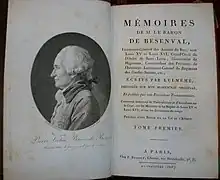
in alphabetical order
- Olivier Bauermeister: Le nymphée de l'hôtel de Besenval, Zeitschrift « Kunst und Architektur in der Schweiz », 2013, Band 64, Heft 2
- Pierre Victor, Baron de Besenval de Brunstatt: Mémoires de M. Le Baron de Besenval, écrits par lui-même, imprimés sur son manuscrit original et publiés par son exécuteur testamentaire M. A. J. de Ségur, imprimerie de Jeunehomme, rue de Sorbonne no. 4, Paris, 1805 – chez F. Buisson, libraire, rue Hautefeuille no. 31, Paris
- Jacques-François Blondel: Architecture Françoise, ou recueil des plans, élévations, coupes et profiles des Eglises, Maisons Royales, Palais, & Edifices les plus considérables de Paris, ainsi que des Châteaux et Maisons de plaisance situés aux environs de cette ville, ou en d’autres endroits de la France, bâtis par les plus célèbres architectes, & mesurés exactement sur les lieux, tome premier, contenant une introduction à l’architecture, un abrégé historique de la ville de Paris, & la description des principaux édifices du Faubourg St. Germain, chapitre XII: Description de l’Hôtel de Pompadour, situé rue de Grenelle. Chez Charles-Antoine Jombert, Libraire du Roi pour le Génie & l’Artillerie, rue Dauphine, Paris, 1752, pp. 236–237
- Germain Brice: Nouvelle description de la ville de Paris et de tout ce qu’elle contient de plus remarquable, 8ème édition, tome III, chez Julien-Michel Gandouin, Quai de Conty, aux trois Verus, et François Fournier, rue S. Jacques, aux Armes de la Ville, Paris, 1725, pp. 453–454
- Gabrielle Claerr Stamm: De Soleure à Paris : La saga de la famille de Besenval, seigneurs de Brunstatt, Riedisheim et Didenheim, Société d’Histoire du Sundgau, 2015
- Jean-Jacques de Dardel: L’hôtel de Besenval – siège de l’ambassade de Suisse en France, Labor et Fides, Genève, 2013
- Jean-Jacques de Dardel: 1663: Le Renouvellement de l’Alliance avec le Roi de France – histoire et tapisserie, Labor et Fides, Genève, 2013
- Jean-Jacques Fiechter: Le Baron Pierre-Victor de Besenval, Delachaux et Niestlé, Lausanne, Paris, 1993
- Jean-Jacques Fiechter: Baron Peter Viktor von Besenval: Ein Solothurner am Hofe von Versailles, Rothus Verlag, Solothurn, 1994
- Jean-Jacques Fiechter / Benno Schubiger: L’Ambassade de Suisse à Paris, Ambassade de Suisse, 2ème édition, août 1994
- Paul Gallois: Baron de Besenval’s eclectic eye, The Furniture History Society, London, Newsletter 221, February 2021, pp. 1–12
- Martin Körner: Allianzen, Historisches Lexikon der Schweiz (HLS), online, Version vom 19.09.2006
- Charles Lefeuve: Histoire de Paris – rue par rue, maison par maison, 5ème édition, tome IV, C. Reinwald et Cie, 15, rue des Saints-Pères, Paris, 1875
- Collections Louvre: Paris, Hôtel de Besenval – nymphée souterrain à l'antique, Département des Arts graphiques, Alexandre Théodore Brongniart ,
- Elisabeth Martin de Clausonne: Ambassades à Paris, Nicolas Chaudun, Paris, 2009
- Sigrid Pallmert: Der Allianzteppich und die Fragen von Selbstdarstellung, Repräsentation und Rezeption, Zeitschrift « Kunst und Architektur in der Schweiz », 2002, Band 53, Heft 1
- Jean-Pierre Samoyault: L'Hôtel de Besenval. Ambassade de Suisse en France, Editions internationales du Patrimoine, Paris, 2017
- Alain Stella: Historic Houses of Paris – Residences of the Ambassadors, Flammarion, Paris, 2010
- Luc-Vincent Thiéry: Guide des amateurs et des étrangers voyageurs à Paris, tome II, chapitre 'Hôtel de M. le Baron de Besenval,' pp. 574–580, Libraire Hardouin & Gattey, Paris, 1787
- Alain-Jacques Tornare: 10 août 1792 – Les Tuileries : L’été tragique des relations franco-suisses, Collection Le savoir suisse – La série « Grandes Dates », presse polytechniques et universitaires romandes, première édition, 2012
- J. Vacquier: Les vieux hôtels de Paris – Le Faubourg Saint-Germain, décorations extérieures et intérieures, tome I, F. Contet, Paris, 1911
External links
- Stéphane Bern and his team visiting the Swiss Ambassador, Bernardino Regazzoni, at the Hôtel de Besenval in 2016
- The Hérès Company was commissioned to create the decorative stone elements of a swimming pool built into the basement of a 17th century hôtel particulier in Paris. For this hôtel particulier, the Hôtel Amelot de Bisseuil, also called Hôtel des Ambassadeurs de Hollande, Hérès came up with décor inspired by antiquity, influenced by a project carried out by Alexandre-Théodore Brongniart around 1782 for Pierre Victor, Baron de Besenval de Brunstatt for his nymphaeum at the Hôtel de Besenval. Hérès designed a swimming pool with a décor of columns, flat vaults and sculptures in the round and in bas-relief with a view to recreating the original ambiance of a nymphaeum in ancient times